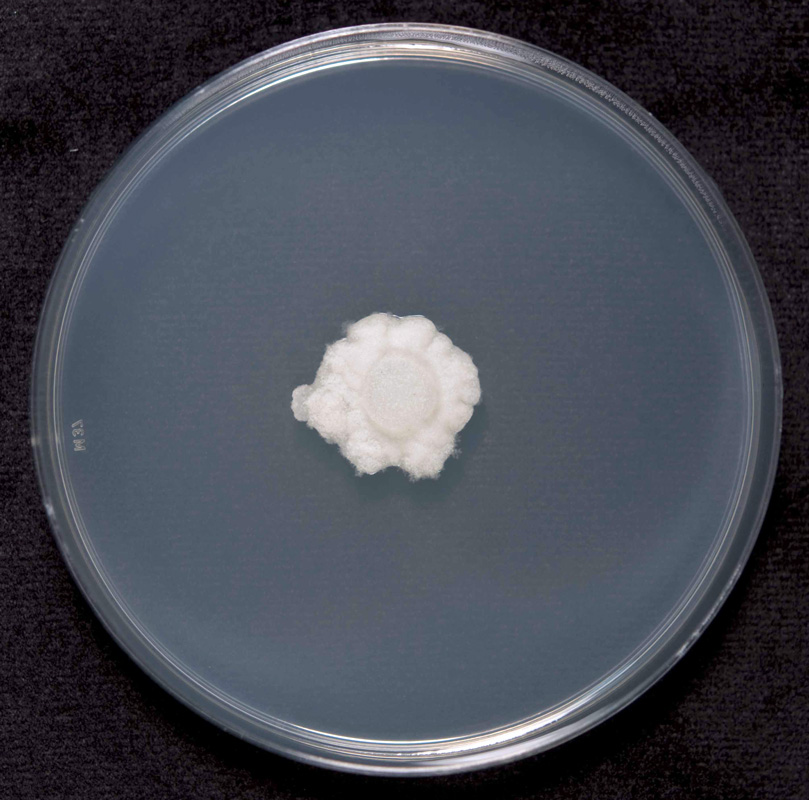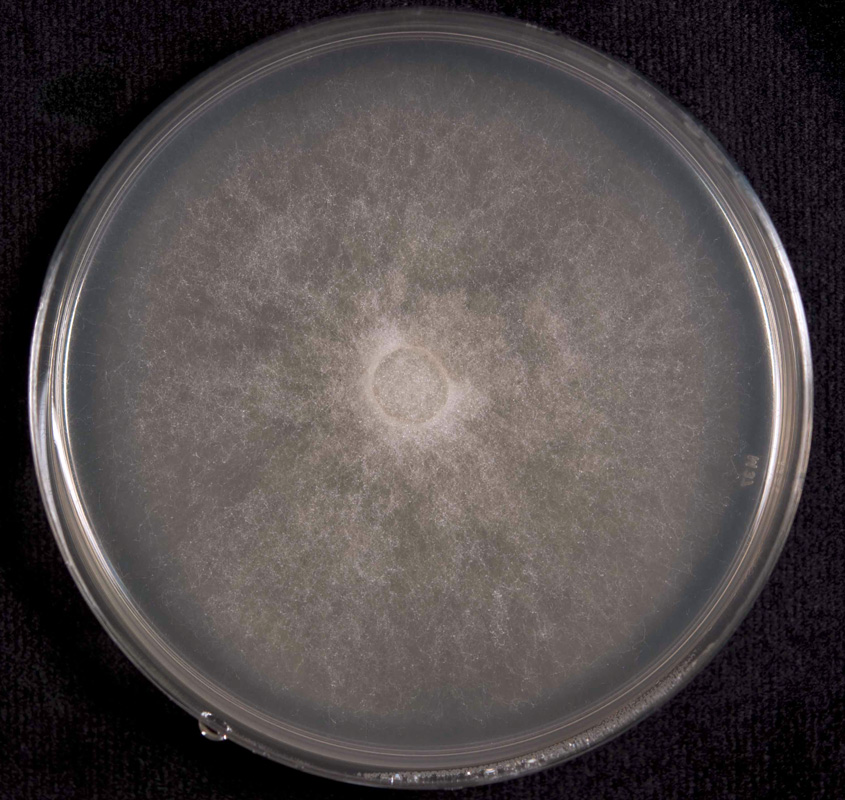Phytophthora syringae (in progress - Abad et al. 2023b)
|
Phytophthora spp. in subclade 8d: portion of the seven-loci ML phylogeny featuring the type cultures of 212 described species (by T. Bourret). Notice the position of P. syringae selected specimen CBS 110161 = S&T BL 57G. Gloria Abad, USDA S&T.
|
|
Phytophthora spp. in subclade 8d: Morphological Tabular key (PDF) and Tabular key legends (PDF) in IDphy2 KEY SECTION. Notice the data of P. syringae selected specimen CBS 110161 = S&T BL 57G. Gloria Abad, USDA S&T.
|
|
Phytophthora syringae (CPHST BL 57G) colony grown for 7 days on potato dextrose agar |
|
Phytophthora syringae (CPHST BL 57G) colony grown for 7 days on V8® Agar |
Name and publication
Phytophthora syringae (Kleb.) Kleb. (1909)
Klebahn H. 1909. Krankheiten des Flieders, pp. 75. Figs. 45. Berlin Gebruder Borntraeger. (Phytophthora syringae)
Nomenclature
Mycobank
Synonymy
≡ Phloeophthora syringae Kleb., Zentbl. Bakt. ParasitKde: 335 (1905) [MB146927]
≡ Nozemia syringae (Kleb.) Pethybr., Scientific Proceedings of the Royal Dublin Society 13 (1913) [MB416474]
Typification
from Klebahn (1909)
Type: GERMANY collected from Syringae vulgaris
Ex-type: LOST
Well-authenticated specimens selected by Gloria Abad:
Selected specimen #1: CPHST BL 57G = P10330 from GERMANY, rhododendron
Selected specimen in other collections
(SE) CBS 110161, NRRL 64329, WPC P10330, S&T BL 57G (Abad), BBA 70008
Molecular identification
Voucher sequences for barcoding genes (ITS rDNA and COI) of the selected specimen (see Molecular protocols page)
Phytophthora syringae isolate CPHST BL 57G (= P10330 WPC) = ITS rDNA MG865590, COI MH136982
Voucher sequences for Molecular Toolbox with seven genes (ITS, β-tub, COI, EF1α, HSP90, L10, and YPT1
(see Molecular protocols page) (In Progress)
Voucher sequences for Metabarcoding High-throughput Sequencing (HTS) Technologies [Molecular Operational Taxonomic Unit (MOTU)]
(see Molecular protocols page) (In Progress)
Sequences with multiple genes for selected specimen in other sources
- NCBI: Phytophthora syringae CPHST BL 57G
- NCBI: Phytophthora syringae P10330
- NCBI: Phytophthora syringae CBS 110161
- EPPO-Q-bank: Phytophthora syringae CBS 110161 ITS, β-TUB, COI, TEF
Position in multigenic phylogeny with 7 genes (ITS, β-tub, COI, EF1α, HSP90, L10, and YPT1)
Clade clade:
a taxonomic group of organisms classified together on the basis of homologous features traced to a common ancestor
8d
Genome sequence
Phytophthora syringae strain ex-neotype BL57G. Accession genome USDA_Psyr_BL57G_1.0 reference, BioProject PRJNA605765, USDA-APHIS-PPQ-S&T (2020), Srivastava et al 2022
Morphological identification
Colonies and cardinal temperatures
Colony colony:
assemblage of hyphae which usually develops form a single source and grows in a coordinated way
on CMA with no special pattern, on PDA and V-8 with chrysanthemum/rosette pattern. The minimum temperature for growth is 5°C, the optimum is 18–20°C, and the maximum is 23–25°C.
Conditions for growth and sporulation
Oogonia form abundantly in culture and host tissues.
Asexual phase
SporangiaSporangia:
sac within which zoospores form, especially when water is cooled to about 10°C below ambient temperature; in solid substrates, sporangia usually germinate by germ tubes
semipapillatesemipapillate:
pertaining to the production of shallow having papilla that are not well developed, shallow and less nipple-like than fully papillate structures
; persistentpersistent:
pertaining to sporangia that remain attached to the sporangiophore and do not separate or detach easily (cf. caducous)
; broad ovoidovoid:
egg-shaped, with the widest part at the base of the sporangium and the narrow part at the apex
, ellipsoidellipsoid:
refers to a solid body that forms an ellipse in the longitudinal plane and a circle in cross section; many fungal spores are ellipsoidal or elliptic
, obpyriformobpyriform:
inversely pear-shaped, i.e. with the widest part at the point of attachment (cf. pyriform)
, or distorted shapes (20–65 µm length x 18–40 µm width) sometimes with tapered basetapered base:
pertaining to the base of a sporangium or oogonium; funnel-shaped
; originated in close simple sympodial sporangiophores with intercalaryintercalary:
positioned within a hypha (cf. terminal)
swellings. Hyphal swellings often catenulated, and spherical or irregular shape. ChlamydosporesChlamydospores:
an asexual spore with a thickened inner wall that is delimited from the mycelium by a septum; may be terminal or intercalary, and survives for long periods in soil
absent.
Sexual phase
Homothallichomothallic:
pertaining to sexual reproduction that can take place within a single thallus (i.e. self-fertile, non-outcrossing) (cf. heterothallic).
. Oogoniumoogonium:
the female gametangium in which the oospore forms after fertilization by the antheridium
smooth-walled, globoseglobose:
having a rounded form resembling that of a sphere
(25–47 µm diam.), sometimes with tapered basetapered base:
pertaining to the base of a sporangium or oogonium; funnel-shaped
; antheridiaantheridia:
the male gametangium; a multinucleate, swollen hyphal tip affixed firmly to the wall of the female gametangium (the oogonium)
spherical, ovoidovoid:
egg-shaped, with the widest part at the base of the sporangium and the narrow part at the apex
or club-shaped and are predominately paragynousparagynous:
pertaining to the sexual stage in which the antheridium is attached to the side of the oogonium (cf. amphigynous)
and rarely amphigynousamphigynous:
pertaining to the sexual stage in which the antheridium completely surrounds the stalk of the oogonium (cf. paragynous)
, sometimes with digitate projections; and oosporesoospores:
zygote or thick-walled spore that forms within the oogonium after fertilization by the antheridium; may be long-lived
pleroticplerotic:
pertaining to an oospore that fills the oogonium (cf. aplerotic)
, apleroticaplerotic:
pertaining to a mature oospore that does not fill the oogonium; i.e. there is room left between the oospore wall and oogonium wall (cf. plerotic)
, or slightly apleroticaplerotic:
pertaining to a mature oospore that does not fill the oogonium; i.e. there is room left between the oospore wall and oogonium wall (cf. plerotic)
(20–39 µm diam.).
Specimen(s) evaluated
Phytophthora syringae CPHST BL 57G = P10330 (World Phytophthora Collection)
Hosts and distribution
Distribution: Africa (Morocco, South, Africa), Australia, Asia (Korea) Europe (Italy), North America (Canada, USA), South America (Argentina, Brazil, Chile)
Substrate: roots, shoots, twigs, trunks, leaves, fruits
Disease note: twig blight, fruit rot, root rot, gummosis of citrus, stem canker, wilt, crown rot, collar rot; downy mildew, leaf spot, and shoot dieback of lilac
Host: 29 genera in 14 families, including Syringa vulgaris (Oleaceae) and Rosaceae
Retrieved February 01, 2018 fromU.S. National Fungus Collections Nomenclature Database.
Quarantine status
no quarantine for Phytophthora syringae as it is very prevalent and widely distributed around the world
Additional references and links
Phytophthora syringae in OSU Phytophthora Online course: Training for Nursery Growers. Oregon State University.
- SMML USDA-ARS: Phytophthora syringae
- EPPO Global Database: Phytophthora syringae
- Forest Phytophthora of the world: Phytophthora syringae
- CABI Digital Library: Phytophthora syringae
- Encyclopedia of Life (EOL): Phytophthora syringae
- Index Fungorum (IF): Phytophthora syringae
- Google All Phytophthora syringae
- Google Images Phytophthora syringae
- Google Scholar Phytophthora syringae
Fact sheet author
Z. Gloria Abad, Ph.D., USDA-APHIS-PPQ-S&T Plant Pathogen Confirmatory Diagnostics Laboratory (PPCDL), United States of America.



